Physical Address
304 North Cardinal St.
Dorchester Center, MA 02124
Fractures of the thoracolumbar region are the most common injuries of the vertebral column, with the leading cause of significant thoracolumbar injury being high-energy and high-velocity trauma.
Critical factors necessitating evaluation include: neurological status, stability of the spine, extent of deformity, and associated injuries.
Four major classification systems for thoracolumbar injuries: the Denis three-column system, the Magerl AO system, the Thoracolumbar Injury Classification System, and most recently the AOSpine Thoracolumbar Spine Injury Classification System.
Uncomplicated compression and stable burst fractures of the thoracolumbar spine are often treated with physical therapy alone, orthoses, or hyperextension casts.
Operative treatment is warranted for unstable injuries, that is, flexion-distraction injuries, fracture-dislocations, and unstable burst fractures.
Indications for operative intervention include neurological compromise, fracture instability, and disruption of the posterior ligamentous complex with the potential for progressive deformity.
Surgery has been shown to arrest neurological progression, improve spinal alignment, and hasten early mobilization.
The authors wish to thank Drs. Osama Kashlan, Paul Park, and Frank La Marca for their contributions to the previous edition of this chapter.
Significant thoracolumbar injuries generally result from high-energy trauma, including motor vehicle collisions (MVCs), and gunshot wounds. Low-energy trauma, however, is the leading cause of thoracolumbar injury in the elderly, as osteoporosis leaves this population especially susceptible to injury from falls. Despite declining rates of MVCs, the incidence of spinal injuries has continued to increase in recent decades, and thoracolumbar injuries remain the most commonly observed vertebral column injuries. , ,
Functionally, the thoracolumbar spine is comprised of three anatomically unique regions: the thoracic spine, the thoracolumbar junction, and the lumbar spine. The thoracic spine, particularly T1 to T10, is comparatively inflexible because of a combination of thin intervertebral discs, coronally oriented facet joints, and the rib cage, which offers additional stability. This functional rigidity protects the thoracic spine from mechanical forces and resultant injury, although fractures and dislocations in this region are more likely to lead to neurological injury because of its inherently narrower spinal canal. In contrast, the lumbar spine, specifically L3 to L5, is afforded increased flexibility by nature of its larger intervertebral discs, sagittally oriented facet joints, and absence of a rib cage. The thoracolumbar junction, spanning from T10 to L2, represents a transitional zone between the functionally rigid thoracic spine and relatively flexible lumbar spine. This exposes the region to significantly higher amounts of mechanical stress compared with the rest of the spine. , As a result, over 50% of thoracolumbar injuries occur in the transitional zone, particularly at L1, followed by up to 40% in the thoracic spine and up to 14% in the lumbar spine. ,
Diagnosis of spinal injury, especially of the thoracolumbar spine, is often delayed or missed in severe trauma victims. This has been attributed to numerous factors, including distracting injuries, mental status changes, suboptimal or absent imaging studies, noncontiguous spinal injuries, and failure to seek medical attention. An analysis of the German Trauma Society’s Trauma Register concluded that almost 50% of severe spinal injuries were not clinically suspected during the initial patient trauma evaluation, and further studies have demonstrated that subsequent diagnosis of thoracolumbar injuries can take as long as a month in patients initially misdiagnosed. As nearly half of significant thoracolumbar fractures are estimated to be unstable, this places patients at increased risk of permanent deformity and disability. The significance of timely diagnosis of these injuries cannot be understated.
Any patient subjected to high-energy trauma should be thoroughly examined using guidelines established by Advanced Trauma Life Support protocols. Additionally, once preliminarily stabilized, patients should be thoroughly examined for spine injuries, including identifying the presence of tenderness, step-offs, gaps between spinous processes, or malalignment, any of which may suggest spinal instability. A complete neurological examination is essential to identify any deficits that may have resulted from spinal column injury, including the status of the bulbocavernosus reflex, as this can aid diagnosis of spinal shock, as well as rectal tone and perineal pinprick sensation, which assist in assessing the vitality of the sacral nerve tracts, i.e., sacral sparing. More frequently, the benefit of high-dose methylprednisolone in the treatment of acute spinal cord injuries has been questioned; therefore, administration of steroids should be based upon provider preference and patient-specific factors.
For thoracolumbar fractures resulting in spinal cord injury (SCI), the American Spinal Injury Association (ASIA) Impairment Scale is useful for classifying both the severity of SCI and its associated prognosis ( Table 37.1 ). SCIs can range from complete loss of motor and sensory function below the level of injury, designated ASIA A, to completely recovered motor and sensory function, designated ASIA E. Patients with ASIA A injuries have an 8.3% probability of walking independently at 1 year postinjury, compared with ASIA B with a 39.4% probability, ASIA C with a 61.8% probability, and ASIA D with a 97.3% probability.
| A | Complete | No motor or sensory function is preserved in sacral segments S4‒S5. |
| B | Incomplete | Sensory function, but not motor function, is preserved below the neurological level, including sacral segments S4‒S5. |
| C | Incomplete | Motor function is preserved below the neurological level, and more than half of the key muscles below the neurological level have a muscle grade of less than 3. |
| D | Incomplete | Motor function is preserved below the neurological level, and at least half of the key muscles below the neurological level have a muscle grade of 3 or more. |
| E | Normal | Motor and sensory function are normal. |
Diagnostic imaging is critical to identifying and classifying injuries of the thoracic and lumbar spine, especially given their variable and occasionally occult clinical presentations. In terms of plain radiographs, anteroposterior and lateral views are the gold standard following spinal trauma. However, multidetector computed tomography is now routinely used, given its high sensitivity and specificity for detecting these injuries. Fine-cut axial and sagittal reconstructions also provide information regarding stability and the integrity of the spinal canal. Magnetic resonance imaging (MRI) scans are generally reserved for examining the soft tissue envelope after identification of a thoracolumbar fracture, assessing the integrity of neurological structures in patients with deficits, and identifying possible ligamentous or occult bony injuries in patients with negative radiographs but clinical presentation highly consistent with spine injury. ,
Several classification systems have been proposed to provide a universal language for discussing thoracolumbar injuries and to capture the most important characteristics for guiding treatment of these fractures. Today, the most commonly used classification systems for thoracolumbar injury are the Denis three-column system, the Margel AO System, the Thoracolumbar Injury Classification System (TLICS), and most recently, the AOSpine Thoracolumbar Spine Injury Classification System.
Formulated in 1983, the Denis three-column system was the earliest of the four proposed classification systems listed above used for thoracolumbar fractures, and many of its core principles have been incorporated into more modern classification systems. In this classification system, spinal injuries are divided into major and minor categories, referencing three distinct regions of the spinal elements, termed “columns,” when describing the location of injury ( Fig. 37.1 ). The anterior column is composed of the anterior longitudinal ligament, the anterior annulus fibrosis, and the anterior part of the vertebral body. The middle column comprises the posterior half of the vertebral body, including the annulus fibrosus and posterior longitudinal ligament. Finally, the posterior column includes the region from the posterior longitudinal ligament to pedicle, and associated posterior soft tissue elements.
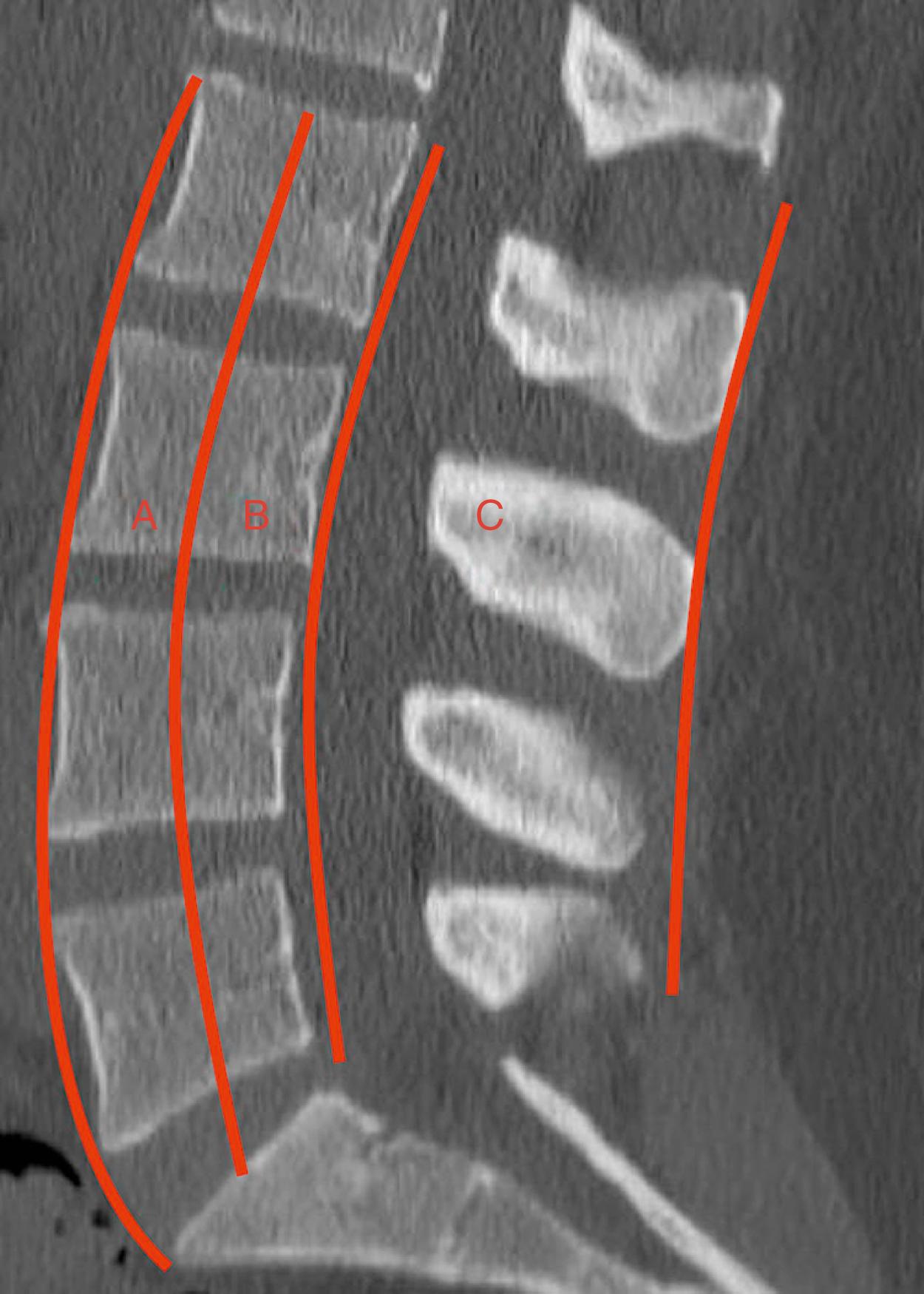
Denis describes four major types of thoracolumbar fractures: compression fracture, burst fracture, seatbelt-type injuries, and fracture-dislocations. A compression fracture occurs when the anterior column is compressed while the middle column stays intact; however, in more severe cases the posterior column can be distracted ( Fig. 37.2 ). In comparison, a burst fracture is a failure of both the anterior and middle columns owing to an axial load, whereas the posterior column remains intact ( Fig. 37.3 ). In seatbelt-type injuries, there is distraction of both the posterior and middle columns because of tension forces produced by flexion, and although the anterior column may compress under these forces, it continues to act as a hinge ( Fig. 37.4 ). Finally, a fracture-dislocation is the most unstable of the injuries, caused by a failure of all three columns because of compression, tension, rotation, or shear forces ( Fig. 37.5 ). Fraction-dislocations most often occur at the thoracolumbar junction and have been associated with neurological injury in up 75% of cases, with 52% of neurologically injured fracture-dislocation patients demonstrating complete paraplegia.
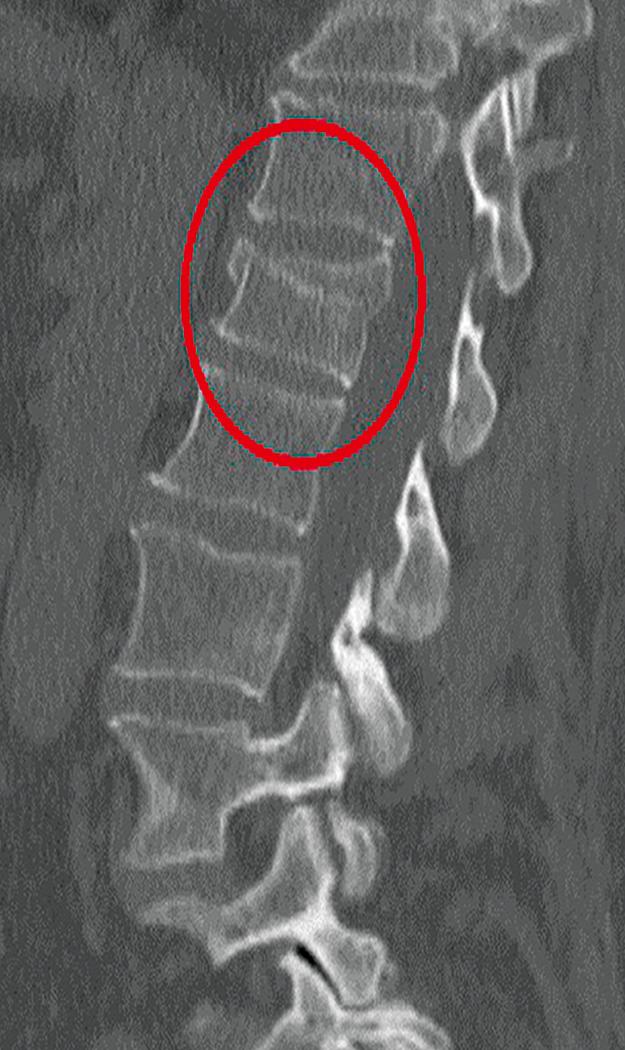
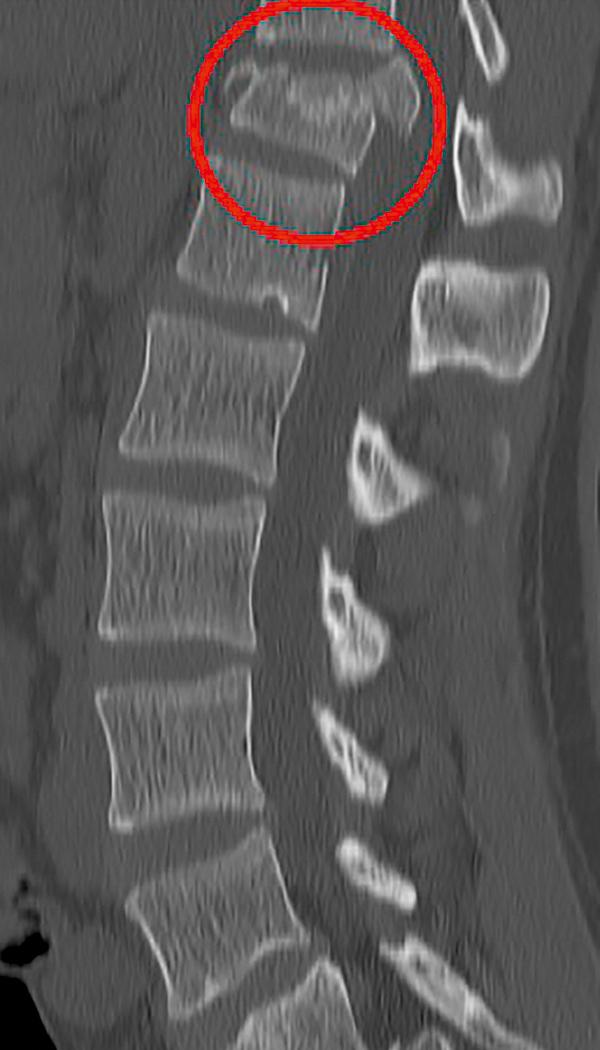
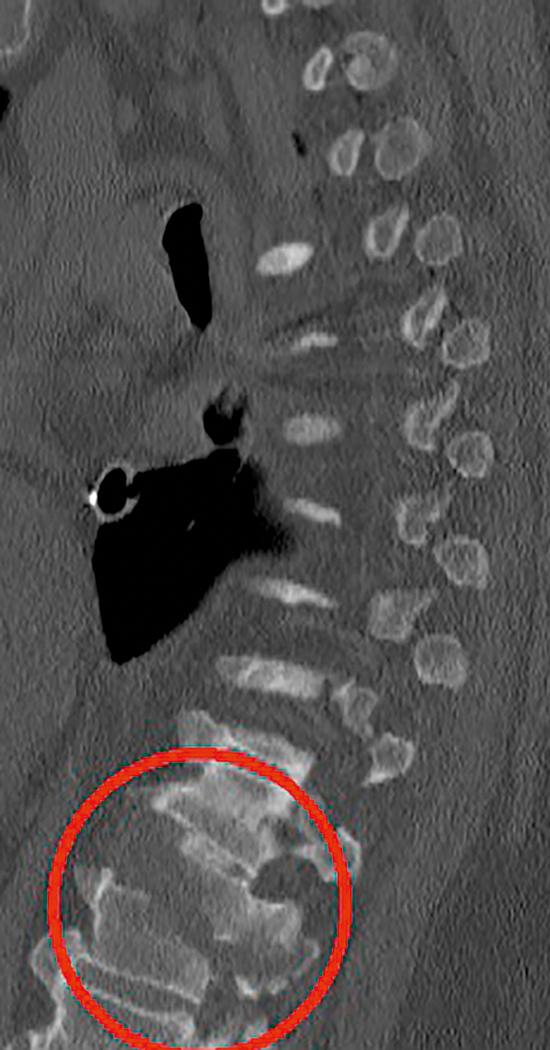
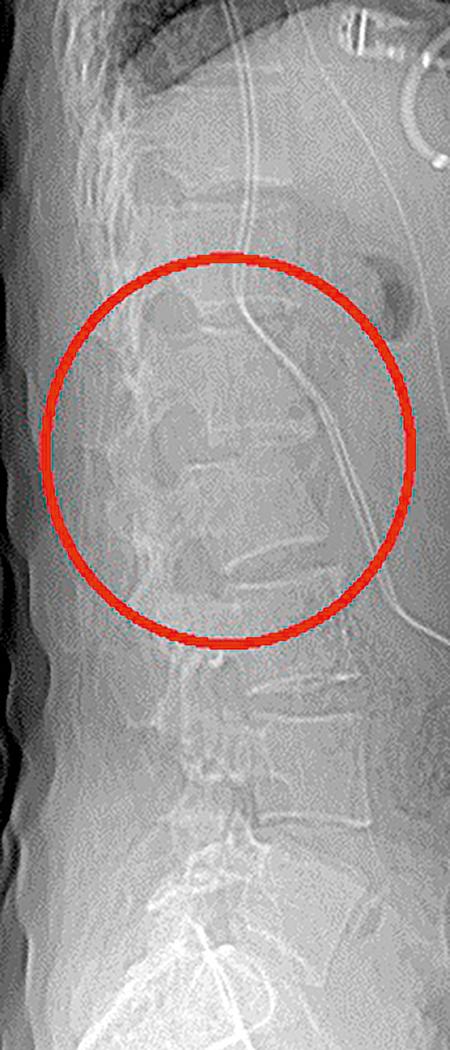
In addition to major injuries, Denis identifies four types of minor injuries, which include fractures of the transverse processes, facets, pars interarticularis, and spinous processes. These minor fractures are more localized, involving only a part of the posterior column, and rarely cause acute spine instability. , Patients with transverse process fractures were noted to have more neurological deficits in the T1‒T2 and L4‒L5 regions, whereas those with spinous process fractures tended to have more temporary loss of neurological functions, which were regained around 1 week postinjury. Facets and pars interarticularis fractures rarely resulted in associated neurological deficits.
The Denis system was the first classification model to account for clinical symptomatology, which influenced treatment plans by introducing the concept of “degrees of instability” that could be mechanical or neurological in nature. Mechanical instability is caused by fractures that decrease the structural integrity of the spine, whereas neurological instability pertains to those that increase the vulnerability of the patient to spinal cord or peripheral nerve injuries. First-degree instability is characterized by mechanical instability only, second-degree instability is characterized by neurological instability only, and third-degree instability is characterized by both mechanical and neurological instability. In regards to treatment plans, it was recommended that two- or three-column injuries be treated with surgical intervention; however, more recent studies have demonstrated that nonoperative treatments are just as viable for these types of injuries, and could even provide better long-term function and reduced pain. Although components of this system have been incorporated in more modern classifications, the Denis three-column system has been criticized for its poor interrater reliability and its inability to distinguish between stable and unstable burst fractures. ,
Become a Clinical Tree membership for Full access and enjoy Unlimited articles
If you are a member. Log in here